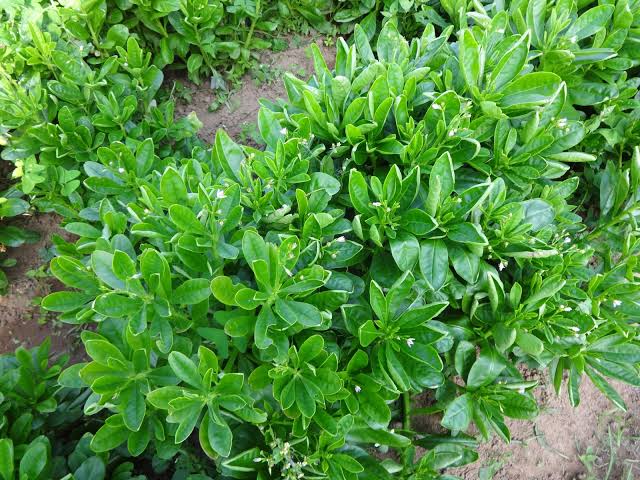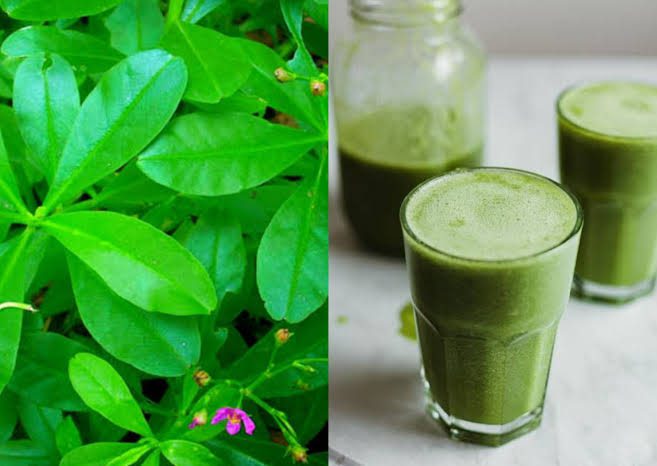Waterleaves (Talinum fruticosum) is a herbaceous perennial plant that belongs to the family Portulacaceae. It is native to tropical regions of the Americas and is commonly found in wetlands, along riverbanks, and in other moist environments. Waterleaves are often grown as a vegetable crop for their edible leaves, which are high in vitamins A and C.
Waterleaves are typically small, growing up to 30cm in height. They have thin, succulent stems and leaves that are bright green and ovate in shape. The leaves are arranged alternately along the stem and can grow up to 5cm long. Waterleaves produce small, pink or white flowers that are arranged in clusters at the end of the stems. The plant produces small, round fruits that contain seeds.
Waterleaves are easy to grow and can be propagated from seeds or stem cuttings. They prefer moist, well-draining soil and thrive in partial shade to full sun. The plants require regular watering and can be fertilized with a balanced fertilizer every two weeks during the growing season. Waterleaves can be harvested when they are young and tender, and the leaves can be eaten raw or cooked in soups, stews, or stir-fries.
In traditional medicine, waterleaves have been used to treat a variety of ailments, including fever, stomachaches, and wounds. The plant contains compounds that have anti-inflammatory and antioxidant properties and may be useful in the treatment of certain diseases. However, more research is needed to fully understand the potential health benefits of waterleaves.
However, waterleaves are a versatile and nutritious plant that can be enjoyed both for their ornamental value and as a source of food and medicine.
Read Also: Maize Definition and Economic Importance
Description of Waterleaves

Waterleaves produce small, pink or white flowers that are arranged in clusters at the end of the stems. The plant also produces small, round fruits that contain seeds.
Waterleaves are native to tropical regions of the Americas and are commonly found in wetlands, along riverbanks, and in other moist environments. They are easy to grow and can be propagated from seeds or stem cuttings. Waterleaves prefer moist, well-draining soil and thrive in partial shade to full sun. The plants require regular watering and can be fertilized with a balanced fertilizer every two weeks during the growing season.
Waterleaves are often grown as a vegetable crop for their edible leaves, which are high in vitamins A and C. The leaves can be eaten raw or cooked in soups, stews, or stir-fries. Waterleaves have also been used in traditional medicine to treat fever, stomachaches, and wounds due to their anti-inflammatory and antioxidant properties.
Overall, Waterleaves are a versatile and nutritious plant that can be enjoyed for their ornamental value as well as their culinary and medicinal uses.
Health Benefits of Waterleaves

Promotes Digestive Health: Waterleaves contain fiber, which can help promote regular bowel movements and prevent constipation.
Boosts Immunity: Waterleaves are a good source of vitamin C, which is essential for the proper functioning of the immune system.
Improves Eyesight: Waterleaves contain high levels of vitamin A, which is important for maintaining good vision.
Reduces Inflammation: Waterleaves contain anti-inflammatory compounds that may help reduce inflammation and alleviate symptoms of inflammatory conditions such as arthritis.
Lowers Cholesterol Levels: Waterleaves have been shown to help lower cholesterol levels in the blood, which can reduce the risk of heart disease.
Prevents Anemia: Waterleaves are a good source of iron, which is important for the production of red blood cells and the prevention of anemia.
Regulates Blood Sugar: Waterleaves contain compounds that may help regulate blood sugar levels, which can be beneficial for people with diabetes.
Improves Bone Health: Waterleaves are a good source of calcium and magnesium, which are important for maintaining strong bones.
Prevents Cancer: Waterleaves contain antioxidants that may help prevent the formation of cancer cells.
Promotes Weight Loss: Waterleaves are low in calories and high in fiber, which can help promote weight loss.
Alleviates Respiratory Issues: Waterleaves contain compounds that may help alleviate respiratory issues such as coughs and colds.
Reduces Anxiety and Depression: Waterleaves contain compounds that may help reduce anxiety and depression.
Improves Skin Health: Waterleaves are rich in antioxidants, which can help protect the skin from damage caused by free radicals.
Prevents Cardiovascular Disease: Waterleaves contain compounds that may help prevent cardiovascular disease by reducing inflammation and improving cholesterol levels.
Enhances Brain Function: Waterleaves contain compounds that may help enhance brain function and improve cognitive performance.
Anti-Bacterial: Waterleaves have been shown to have antibacterial properties that can help fight against harmful bacteria in the body.
Improves Liver Health: Waterleaves contain compounds that may help improve liver function and protect the liver from damage caused by toxins.
Additionally, consuming waterleaves may have numerous health benefits and is a great addition to a healthy and balanced diet. However, it is important to consult with a healthcare professional before making any major changes to your diet or lifestyle.
Uses of Waterleaves

Cooking: Waterleaves are often used in cooking and are a popular vegetable in many parts of the world. The leaves can be eaten raw or cooked and are often used in soups, stews, and stir-fries.
Medicinal Use: Waterleaves have been used in traditional medicine to treat various ailments, such as fever, stomachaches, and wounds. They are believed to have anti-inflammatory, antioxidant, and antibacterial properties.
Ornamental Use: Waterleaves are a beautiful plant with bright green leaves and delicate pink or white flowers. They can be grown as an ornamental plant in gardens, pots, or containers.
Soil Improvement: Waterleaves are known to improve the quality of the soil they grow in. They can help prevent soil erosion, improve soil fertility, and increase soil water-holding capacity.
Livestock Feed: Waterleaves can also be used as a feed for livestock. They are rich in nutrients and can be fed to animals such as cattle, goats, and rabbits.
Cosmetics: The antioxidants found in waterleaves can also be used in cosmetic products to protect the skin from damage caused by free radicals.
Insect Repellent: The leaves of waterleaves can be crushed and rubbed on the skin to repel insects such as mosquitoes.
Traditional Rituals: Waterleaves have cultural significance in some traditional rituals in certain parts of the world, such as in some parts of West Africa.
In addition, waterleaves have various uses, from culinary to medicinal, ornamental to soil improvement, and even in cosmetics and traditional rituals. These versatile plants are a great addition to any garden and can be used in various ways to benefit human health and the environment.
Read Also: All About Black-Eyed Susan Flower (Rudbeckia hirta)
How to Grow and Harvest Waterleaves
Choose a suitable location: Waterleaves prefer a well-drained soil that is rich in organic matter. They can grow in full sun or partial shade, but they need at least 6 hours of direct sunlight per day.
Plant the seeds: Waterleaves can be grown from seeds, which should be planted in the soil at a depth of about 1 cm. Space the seeds about 15 cm apart.
Water the seeds: Waterleaves need to be kept moist, so water them regularly. However, do not overwater, as this can lead to root rot.
Fertilize the plants: Waterleaves respond well to regular fertilization. Use a balanced fertilizer every 4 to 6 weeks during the growing season.
Harvest the leaves: Waterleaves can be harvested when they are about 10 cm long. Harvest by cutting the leaves with scissors, making sure to leave some leaves on the plant for continued growth.
Store the leaves: Waterleaves can be stored in the refrigerator for up to a week. Before storing, wash the leaves and dry them thoroughly.
Propagate the plants: Waterleaves can be propagated by taking stem cuttings and planting them in soil. Make sure the soil is moist, and keep the cuttings in a warm, bright location.
In summary, waterleaves are easy to grow and can be harvested and stored for later use. Make sure to provide them with adequate sunlight, water, and nutrients, and harvest the leaves regularly to encourage continued growth.
Read Also: Sources and Types of Pollution on the Environment
